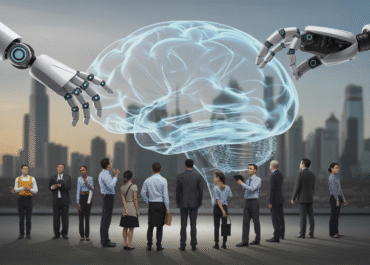Discover the Future of Automation Technologies in Innovation

Unlocking Tomorrow’s Efficiency: Key AI Automation Trends and Business Wins
By 2025, over 70% of companies will be leveraging at least three hyperautomation technologies. This signals a major shift: automation is no longer just a nice-to-have, it’s crucial for top-notch operations. In this deep dive, we’ll break down what’s next in automation, the AI-powered trends set to dominate 2025 and beyond, how to implement them like a pro, the real business wins you can expect, and the common hurdles to watch out for.
What’s New in Automation and Its Core Tech?
The next generation of automation blends cutting-edge AI, smart machine learning, and robotic process automation. The result? Workflows that adapt, run end-to-end, and supercharge your efficiency and agility.
Before we get into the specifics, here’s what defines this new wave of automation:
- AI that makes smart decisions and adjusts on the fly.
- Seamless integration across all your systems and processes.
- The power to scale and orchestrate both digital and human teams.
These building blocks pave the way for hyperautomation, intelligent automation, and cognitive tech.
Intelligent Automation: The 2025 Adoption Forecast
Get this: 80% of businesses are expected to embrace intelligent automation by 2025. This isn’t just a trend; it’s a fundamental shift towards embedding AI’s thinking power into business operations, using tools like Natural Language Processing and predictive analytics to sharpen decision-making and forecasting.
This insight perfectly backs up our point about the rapid rise of AI-powered automation and its game-changing impact on how businesses operate by 2025.
How Does Hyperautomation Power Your Digital Team?
Hyperautomation brings together distributed software bots, process mining tools, and AI engines to automate complex, cross-departmental tasks, cutting down on manual handoffs. By weaving together RPA, analytics, and low-code platforms, it speeds up execution and slashes errors. Understanding how intelligent automation builds on this orchestration is key to truly transforming your business processes.
What is Intelligent Automation and How Does It Elevate Your Business?
Intelligent automation merges AI algorithms with RPA to tackle tasks that require complex decision-making. Think dynamic routing, self-improving workflows, and smart exception handling that boost accuracy and output. This fusion of cognitive power and rule-based automation handles more intricate processes and sets the stage for predictive and generative AI to drive proactive operations.
Which AI and Cognitive Automation Tools Are Leading the Charge?
A host of AI and cognitive automation tools are fueling today’s innovations, from understanding language to seeing the world:
| Technology | What It Does | The Impact |
|---|---|---|
| Natural Language Processing | Understands and creates human language | Automates customer chats and document handling |
| Computer Vision | Analyzes images and video feeds | Enables automated quality checks and security monitoring |
| Machine Learning Models | Finds patterns in data | Powers proactive maintenance and sales forecasts |
| Decision Intelligence | Uses advanced analytics for decision-making | Optimizes delivery routes and resource deployment |
These technologies combine to create systems that don’t just perform tasks—they learn. This brings us to the cutting-edge AI automation trends shaping the near future.
What Are the Hottest AI Automation Trends for 2025 and Beyond?
Emerging AI automation trends like predictive analytics and generative AI are driving smarter decisions and sparking creativity, boosting both efficiency and innovation.
Here are the key trends to watch:
- Predictive Automation: For real-time equipment upkeep and smarter supply chains.
- Generative AI: For creating content, designs, and even process plans automatically.
- Edge AI: Bringing intelligence closer to the source for faster, more resilient operations.
These trends are changing how businesses anticipate what’s next, making predictive automation’s transformative power a must-see.
How Is Predictive Automation Revolutionizing Business?
Predictive automation uses machine learning to forecast equipment failures, resource needs, and customer behavior. This means less downtime, optimized inventory, and better service, all proactively managed. By turning past data into future insights, companies move from fixing problems to strategically planning for sustained efficiency.
What’s Generative AI’s Role in Future Automation?
Generative AI leverages neural networks to create new text, images, and process designs. It automates creative and planning tasks that used to demand human ingenuity. This accelerates everything from product prototyping and marketing content creation to dynamic process modeling, paving the way for truly adaptive, self-optimizing workflows.
How Can Your Business Master Advanced Automation Implementation?
Successfully rolling out advanced automation solutions requires a smart strategy that links technology choices with clear business goals to ensure a solid return on investment.
A streamlined roadmap looks like this:
- Pinpoint your objectives and key performance indicators (KPIs) that align with your business vision.
- Audit your processes to find the automation opportunities with the biggest impact.
- Choose scalable tools and platforms that play well with your current systems.
- Test with cross-functional teams to confirm your approach and fine-tune workflows.
- Expand gradually, keeping a close eye on performance and adjusting your governance as needed.
This structured path naturally leads to the crucial topic of change management.
What Are the Essential Steps for Crafting a Winning Automation Strategy?
A winning strategy needs everyone on board, detailed process maps, clear KPIs, smart tech choices, and a phased rollout plan. When leaders, IT, and operations are aligned, it ensures smooth execution and accountability at every step of your automation journey.
How Does Smart Change Management Smooth Automation Adoption?
Effective change management involves keeping stakeholders informed with clear communication, providing targeted training, and creating feedback channels to weave automation into your company culture. By addressing concerns early and highlighting quick wins, you build momentum for wider adoption and ongoing innovation.
What Are the Tangible Wins from Hyperautomation and Intelligent Automation?
Hyperautomation and intelligent automation deliver real, measurable benefits by streamlining operations, cutting errors, and enabling personalized customer interactions that fuel growth.
The key advantages include:
- Boosted operational efficiency through automated end-to-end processes.
- Significant cost savings by redeploying staff and eliminating waste.
- Sharper accuracy, reducing rework and compliance headaches.
- Faster throughput and quicker time-to-market for your offerings.
Real-World Gains from Robotic Process Automation (RPA)
Studies show RPA delivers serious cost reductions and efficiency leaps. KPMG research suggests RPA can slash costs in finance by up to 75%, while Roland Berger found companies could achieve 40% annual savings and cut process times by 40–70%.
These figures powerfully support our points about the concrete benefits of automation, especially when it comes to major cost savings and operational efficiency.
These results directly impact both your back-office performance and how you engage with customers on the front lines.
How Does Automation Streamline Operations and Cut Costs?
Automation streamlines operations by removing manual steps, using real-time data for smarter decisions, and freeing up your team for strategic work. Companies see cost reductions in areas like invoice processing, order fulfillment, and IT support, freeing up valuable resources for innovation.
How Does AI-Powered Automation Elevate the Customer Experience?
AI-driven automation enhances customer experiences through personalized suggestions, instant chatbot support, and sentiment analysis that anticipates needs. This leads to happier customers, faster problem resolution, and more meaningful interactions that build loyalty and encourage repeat business.
What Hurdles Do Businesses Face Adopting the Next Wave of Automation?
Businesses often grapple with complex integrations, skill shortages, and security worries when adopting the next wave of automation. Overcoming these requires well-thought-out strategies.
Common challenges include:
- Making different systems talk to each other
- A lack of in-house AI talent
- Issues with data governance
- The challenge of upfront investment
Tackling these obstacles head-on is the first step to finding effective solutions.
What Are Common Roadblocks and How Do You Clear Them?
Common implementation hurdles, like outdated systems or limited AI expertise, can be overcome with phased integration, targeted training, pilot projects, and teams that blend business and tech skills for smooth adoption.
How Can Smart Partnerships Speed Up Your Automation Journey?
Strategic partnerships with tech providers and consultants accelerate automation success by bringing specialized knowledge, scalable platforms, and ongoing innovation support. Working with experts gives you access to best practices, reduces the time it takes to see value, and helps your business stay ahead in the fast-paced world of automation.
Automation innovations promise incredible leaps in efficiency, cost savings, and customer engagement. By setting clear goals, leveraging core AI and automation tech, and teaming up with experienced advisors, organizations can confidently ride the next wave of automation, turning emerging trends into lasting competitive advantages.
—
Let automatizalo.co be your guide. Partner with us for custom AI and automation consulting that transforms your operations and fuels your growth.


